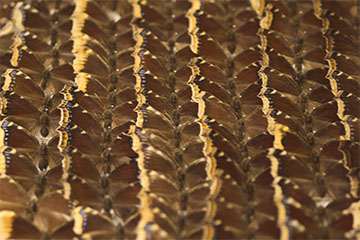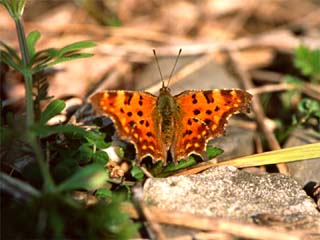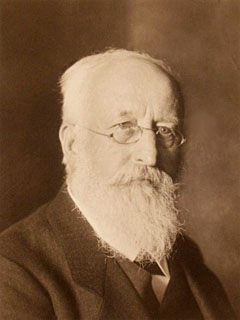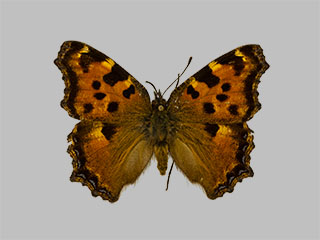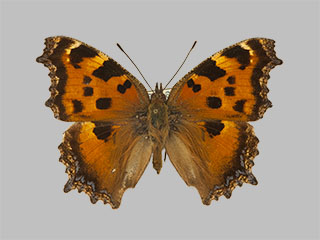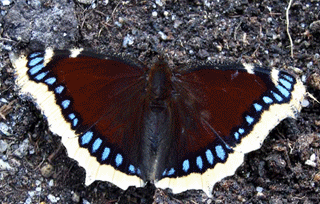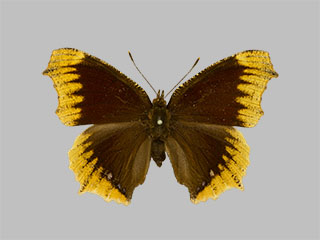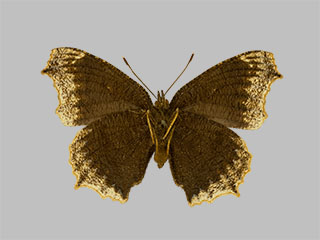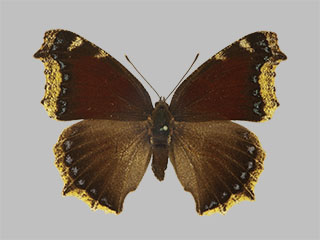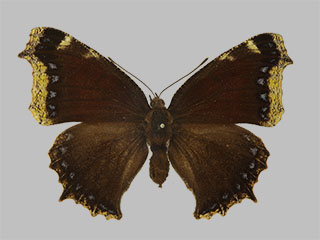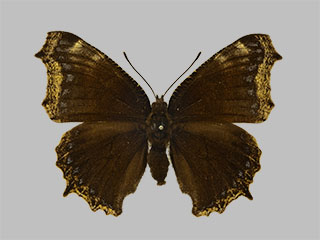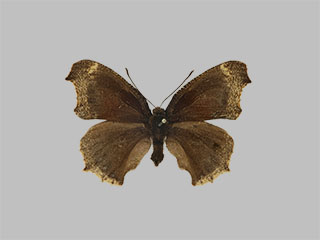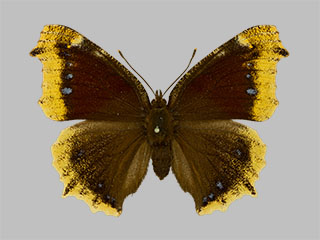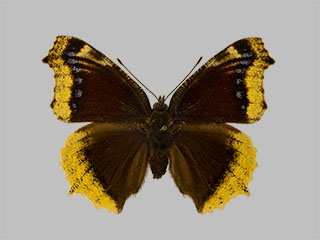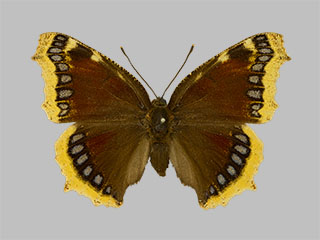Camberwell Beauties (Nymphalis antiopa) at the Museum Koenig, Bonn
Camberwell Beauties (Nymphalis antiopa) in a display case of the collections of the Museum Koenig in Bonn.
Collection: Museum Alexander Koenig, Bonn
By giving caterpillars an unfamiliar food Rühl, 1895 - Die palaearktischen Grossschmetterlinge und ihre Naturgeschichte or exposing chrysalis to extreme temperatures, it is possible to produce aberrant A genetic or environmentally produced variation on the usual form of the speciesaberrations of adult butterflies in individual specimens.
However, the changes in conditions must not be too great: The more extreme the conditions, the smaller the number of surviving chrysalises, but the greater the deviations in the wing markings Friedrich, 1986 - Breeding Butterflies And Moths Moucha; Vancura, 1973 - Schmetterlinge Tagfalter.
Although such forms are artificially created, they also occur in nature under special, rare circumstances. An extremely hot summer can produce such forms.
Towards the end of the 19th and the beginning of the 20th century, the laboratory production of A genetic or environmentally produced variation on the usual form of the speciesaberrations was a favourite subject of many scientific and less scientific investigations.
The following people were particularly involved:
- The mathematician and entomologist Georg Dorfmeister (1810-1881)Georg Dorfmeister, born in Vienna,
 AustriaVienna/
AustriaVienna/ Austria
Austria Austria.
Austria. - The professor of entomology Max Standfuss (1854-1917)Max Standfuss, who works at the Polytechnic in Zürich,
 SwitzerlandZürich/
SwitzerlandZürich/ Switzerland
Switzerland Switzerland.
Switzerland. - The Zürich,
 SwitzerlandZürich/
SwitzerlandZürich/ Switzerland
Switzerland Switzerland doctor and entomologist Emil Fischer (1868-1954)Emil Fischer.
Switzerland doctor and entomologist Emil Fischer (1868-1954)Emil Fischer. - The Bonn,
 GermanyBonn/
GermanyBonn/ Germany
Germany Germany living lepidopterist Karl Frings (1874-1931)Karl Frings.
Germany living lepidopterist Karl Frings (1874-1931)Karl Frings.
The Vienna,  AustriaVienna military accountant and lepidopterist Heinrich Ritter von Mitis (1845-1905)Heinrich Ritter von Mitis writes about A genetic or environmentally produced variation on the usual form of the speciesaberrations Ritter von Mitis, 1896 - Ueber Varietäten und Aberrationen von Schmetterlingen und deren Bedeutung für die Descendenz-Forschung:
AustriaVienna military accountant and lepidopterist Heinrich Ritter von Mitis (1845-1905)Heinrich Ritter von Mitis writes about A genetic or environmentally produced variation on the usual form of the speciesaberrations Ritter von Mitis, 1896 - Ueber Varietäten und Aberrationen von Schmetterlingen und deren Bedeutung für die Descendenz-Forschung:
Not so long ago, collectors who favoured acquiring so-called varieties (or more correctly aberrations), usually for a lot of money, were treated with sovereign disregard by professional scholars for this highly unscientific passion. But how could it be possible to pass off, for example, an abnormally shaped or coloured butterfly, which actually only represents a play of nature, a freak of nature, as a scientifically interesting object, and to show greater interest in it than in an unusually constructed clock or a strangely designed tobacco tin?
...
Finally, a few words about the artificial breeding of varieties that has been diligently pursued in recent times. These breeding experiments, often accompanied by surprising success, are first of all an excellent means of experimentally demonstrating the influences that cause aberrations to develop in free-living animals. Furthermore, since some of the products obtained in this way undoubtedly have an atavistic character, they are excellent aids to unravelling the secrets of descendency. Finally, in so far as they deal with the interbreeding of different species, they provide an excellent means of determining the preponderance of the sexes in the transmission of their relative peculiarities to the offspring.
In July 2005 I was lucky enough to come across a A genetic or environmentally produced variation on the usual form of the speciesaberration in nature: An unusually marked  CommaPolygonia c-album (Linnaeus, 1758)Nymphalis c-albumComma flew along a light forest path near Cochem, Rhineland-Palatinate,
CommaPolygonia c-album (Linnaeus, 1758)Nymphalis c-albumComma flew along a light forest path near Cochem, Rhineland-Palatinate,  GermanyCochem/Mosel.
GermanyCochem/Mosel.
The following photos show a common  CommaPolygonia c-album (Linnaeus, 1758)Nymphalis c-albumComma and an observed A genetic or environmentally produced variation on the usual form of the speciesaberration of the
CommaPolygonia c-album (Linnaeus, 1758)Nymphalis c-albumComma and an observed A genetic or environmentally produced variation on the usual form of the speciesaberration of the  CommaPolygonia c-album (Linnaeus, 1758)Nymphalis c-albumCommas.
CommaPolygonia c-album (Linnaeus, 1758)Nymphalis c-albumCommas.
The wing pattern of the A genetic or environmentally produced variation on the usual form of the speciesaberration looks like softly drawn and was probably caused by unusually high temperatures in the first days of the pupal stage.
It is probably Polygonia c-album f. suffusaPolygonia c-album f. suffusa (Linnaeus, 1758)Polygonia c-album f. suffusa (listed in the online database of the Cockayne Trust, London).
 CommaPolygonia c-album (Linnaeus, 1758)Nymphalis c-albumComma
CommaPolygonia c-album (Linnaeus, 1758)Nymphalis c-albumComma
Comma (Polygonia c-album) on a path between motorway and forest in Bonn-Oberkassel
 CommaPolygonia c-album (Linnaeus, 1758)Nymphalis c-albumComma
CommaPolygonia c-album (Linnaeus, 1758)Nymphalis c-albumComma
Comma (Polygonia c-album) near Klotten/Moselle (probably Polygonia c-album f. suffusa)
Max Standfuss (1854-1917)
Source: Stadtarchiv Schaffhausen (http://www.stadtarchiv-schaffhausen.ch; Schaffhausen, Schweiz).
Max Standfuss (1854-1917)Max Standfuss, Professor of Entomology at the Polytechnic in Zürich,  SwitzerlandZürich/
SwitzerlandZürich/ Switzerland
Switzerland Switzerland, carried out intensive breeding experiments with butterflies over a period of around 30 years from the end of the 19th to the beginning of the 20th century. His research subjects included the
Switzerland, carried out intensive breeding experiments with butterflies over a period of around 30 years from the end of the 19th to the beginning of the 20th century. His research subjects included the  Camberwell BeautyNymphalis antiopa (Linnaeus, 1758)Mourning CloakCamberwell Beauty.
Camberwell BeautyNymphalis antiopa (Linnaeus, 1758)Mourning CloakCamberwell Beauty.
Max Standfuss (1854-1917)Max Standfuss came to the conclusion during his experiments that the temperature conditions to which a chrysalis is exposed during its development can have an influence on the shape and pattern of the wings of the adult butterfliesStandfuss, 1896 - Handbuch der paläarkitischen Gross-Schmetterlinge für Forscher und Sammler.
He divided his test series into heat and cold experiments and compared different constellations:
| Experiment type | Parameter | Results |
|---|---|---|
| a-I: Heat | 48 hours at 37º, then 10 days at room temperature | Border: Wider. Dorsal spots: Reduced. |
| a-II: Heat | 60 hours at 37º, then 24º |
Border: Even wider, darker, wavy bulging.
Postdiscal spots: Still half size, purple stitch.
Black edge, Forewing: Corrugated bulge.
Zeichnung, Underside of wing: Very weak.
Wing base colour, Upperside: Darker.
Wing base colour, Underside: Darker, almost black.
|
| b-I: Cold | 29-34 days ice box, then normal temperatures |
Border: Narrower, duller, darkened by brown and black spots.
Postdiscal spots: Enlarged.
Black edge: Partly only as the edge of the blue postdiscal spots.
Wing base colour: Upperside: Brighter.
|
| b-II: Heat | 39 days ice box, 14-16 days normal temperatures |
Border: Even narrower.
Postdiscal spots: Even larger, partly merging into the border.
Wing base colour, Upperside: Darker.
|
| b-III: Cold | 44 days ice box, 15-19 days normal temperatures |
Border: Even narrower, even darker.
Wing base colour, Forewing: Darker.
Rear wing: Sammet black.
Costal spots: Reduced.
|
| b-IV: Cold | 33 days ice box, 5 days 11º, 15-16 days 19º-23º |
Border: Narrower, paler.
Postdiscal spots: Enlarged, with dark spots.
Wing base colour, upper side: Darker.
Pattern: Underside of wings: Very strong.
|
The deviations resulting from experiment a-II are named Max Standfuss (1854-1917)Max Standfuss Vanessa antiopa var. daubii Stdfs (see Forms/Aberrations (f. daubii)), Standfuss names the deviations resulting from experiment b-III Vanessa antiopa ab. roederi Stdf. (see Forms/Aberrations (f. roederi)).
In experiments b-I and b-II, Max Standfuss (1854-1917)Max Standfuss discovers features on the wings of  Camberwell BeautyNymphalis antiopa (Linnaeus, 1758)Mourning CloakCamberwell Beauty's that ordinary butterflies do not show, but which are present in
Camberwell BeautyNymphalis antiopa (Linnaeus, 1758)Mourning CloakCamberwell Beauty's that ordinary butterflies do not show, but which are present in  Large TortoiseshellNymphalis polychloros (Linnaeus, 1758)Large Tortoiseshell and
Large TortoiseshellNymphalis polychloros (Linnaeus, 1758)Large Tortoiseshell and  Yellow-legged TortoiseshellNymphalis xanthomelasYellow-legged Tortoiseshell! These include, for example, the black round spots in the centre of the forewings of the latter two species.
Yellow-legged TortoiseshellNymphalis xanthomelasYellow-legged Tortoiseshell! These include, for example, the black round spots in the centre of the forewings of the latter two species.
 Large TortoiseshellNymphalis polychloros (Linnaeus, 1758)Large Tortoiseshell
Large TortoiseshellNymphalis polychloros (Linnaeus, 1758)Large Tortoiseshell
Nymphalis polychloros
[57 mm]
Collection: Museum Alexander Koenig, Bonn
 Yellow-legged TortoiseshellNymphalis xanthomelasYellow-legged Tortoiseshell
Yellow-legged TortoiseshellNymphalis xanthomelasYellow-legged Tortoiseshell
Nymphalis xanthomelas ssp. japonica
[65 mm]
Collection: Museum Alexander Koenig, Bonn
Subcollection: W. Panse
Catching:
Kiyose,  JapanKiyose (Tokyo, Kiyose,
JapanKiyose (Tokyo, Kiyose,  JapanTokyo),
JapanTokyo),  Japan
Japan Japan (5. June 1962)
Japan (5. June 1962)
Max Standfuss (1854-1917)Max Standfuss concludes from this, together with other findings, that the  Camberwell BeautyNymphalis antiopa (Linnaeus, 1758)Mourning CloakCamberwell Beauty and the
Camberwell BeautyNymphalis antiopa (Linnaeus, 1758)Mourning CloakCamberwell Beauty and the  Large TortoiseshellNymphalis polychloros (Linnaeus, 1758)Large Tortoiseshell are closely related and that the
Large TortoiseshellNymphalis polychloros (Linnaeus, 1758)Large Tortoiseshell are closely related and that the  Camberwell BeautyNymphalis antiopa (Linnaeus, 1758)Mourning CloakCamberwell Beauty is a stammesgeschichtlichphylogenetisch younger species.
Camberwell BeautyNymphalis antiopa (Linnaeus, 1758)Mourning CloakCamberwell Beauty is a stammesgeschichtlichphylogenetisch younger species.
 Camberwell BeautyNymphalis antiopa (Linnaeus, 1758)Mourning CloakCamberwell Beauty
Camberwell BeautyNymphalis antiopa (Linnaeus, 1758)Mourning CloakCamberwell Beauty
Camberwell Beauty (Nymphalis antiopa) and Large Tortoiseshell (Nymphalis polychloros)
From Camberwell Beauty (Nymphalis antiopa)to Large Tortoiseshell (Nymphalis polychloros) and backwards. Morphing-animation based on images by Gerd Lintzmeyer and Mario Peluso.
Kurt Lampert (1859-1918)Kurt Lampert Lampert, 1907 - Die Großschmetterlinge und Raupen Mitteleuropas mit besonderer Berücksichtigung der biologischen Verhältnisse distinguishes between two groups in the experiments carried out by Max Standfuss (1854-1917)Max Standfuss and others:
Firstly, heat and cold experiments with small temperature differences compared to normal temperatures.
Secondly, heat and frost tests with large temperature differences.
While tests in the first group show results that are also found in nature and all individuals show the same effects, the results of the other test group are much more extreme and only some individuals show the changes.
From experiments conducted by Mr LöfflerLöffler in Heidenheim, Kurt Lampert (1859-1918)Kurt Lampert differentiated between two types of forms:
- Vanessa antiopa L., ab. artemis Fisch. (18 days at 2.5º to 0º)
- Vanessa antiopa L., ab. hygiaea Hdrch. (4 days 2 times 2 hours at -10º)
Kurt Lampert (1859-1918)Kurt Lampert also writes that Max Standfuss (1854-1917)Max Standfuss and others have found that the newly acquired traits are passed on to offspring.
Is that really the case?
Arno Bergmann (1882-1960)Arno Bergmann Bergmann, 1952 - Die Großschmetterlinge Mitteldeutschlands describes the form  Nymphalis antiopa f. hygiaeaNymphalis antiopa f. hygiaea (Linnaeus, 1758)Nymphalis antiopa f. hygiaea as an extreme form that can develop both in severe frost and in intense heat.
Nymphalis antiopa f. hygiaeaNymphalis antiopa f. hygiaea (Linnaeus, 1758)Nymphalis antiopa f. hygiaea as an extreme form that can develop both in severe frost and in intense heat.
See also Subspecies.
Emil Fischer (1868-1954)
The work of the Zürich,  SwitzerlandZürich doctor and Insect scientistEntomologist Emil Fischer (1868-1954)Emil Fischer focussed on experimental lepidopterology with a focus on cold and heat experiments with butterflies of the (at the time) genus VanessaVanessa. In addition, as a supporter of Theory that organisms can pass on characteristics they have acquired during their lifetime to their offspringLamarckism, he was concerned with the heritability of traits acquired in temperature experiments, for example.
SwitzerlandZürich doctor and Insect scientistEntomologist Emil Fischer (1868-1954)Emil Fischer focussed on experimental lepidopterology with a focus on cold and heat experiments with butterflies of the (at the time) genus VanessaVanessa. In addition, as a supporter of Theory that organisms can pass on characteristics they have acquired during their lifetime to their offspringLamarckism, he was concerned with the heritability of traits acquired in temperature experiments, for example.
 Camberwell BeautyNymphalis antiopa (Linnaeus, 1758)Mourning CloakCamberwell Beauty
Camberwell BeautyNymphalis antiopa (Linnaeus, 1758)Mourning CloakCamberwell Beauty
Nymphalis antiopa f. hygiaea
[Breeding image; 62 mm]
Collection: Museum Alexander Koenig, Bonn
Breeding:
Emil Fischer (1868-1954)Emil Fischer;  Switzerland
Switzerland Switzerland
Switzerland
 Camberwell BeautyNymphalis antiopa (Linnaeus, 1758)Mourning CloakCamberwell Beauty
Camberwell BeautyNymphalis antiopa (Linnaeus, 1758)Mourning CloakCamberwell Beauty
Nymphalis antiopa f. hygiaea
[Breeding image; 62 mm]
Collection: Museum Alexander Koenig, Bonn
Breeding:
Emil Fischer (1868-1954)Emil Fischer;  Switzerland
Switzerland Switzerland
Switzerland
He has documented his findings in numerous publications, e.g:
- Fischer, 1894 - Zwei neue Aberrationen von Vanessa antiopa
- Fischer, 1895 - Transmutation der Schmetterlinge in Folge Temperaturänderungen. Experimentelle Untersuchungen über die Phylogenese der Vanessen.
- Fischer, 1898 - Beiträge zur experimentellen Lepidopterologie, Teil V bis X
- Fischer, 1899 - Beiträge zur experimentellen Lepidopterologie, Teil XI bis XII
- Fischer, 1900 - Lepidopterologische Experimental-Forschungen - Kritische Abhandlung über Ursache und Wesen der Kälte-Varietäten der Vanessen - I
- Fischer, 1901 - Experimentelle Untersuchungen über die Vererbung erworbener Eigenschaften
- Fischer, 1901 - Lepidopterologische Experimental-Forschungen - Kritische Abhandlung über Ursache und Wesen der Kälte-Varietäten der Vanessen - II Experimente
- Fischer, 1902 - Lepidopterologische Experimental-Forschungen
- Fischer, 1902 - Drei neue Formen aus der Gruppe der Vanessiden
- Fischer, 1907 - Zur Physiologie der Aberrationen- und Varietäten-Bildung der Schmetterlinge
Emil Fischer (1868-1954)Emil Fischer and Max Standfuss (1854-1917)Max Standfuss were not only contemporaries, but also both lived in the  Switzerland
Switzerland Switzerland in Zürich,
Switzerland in Zürich,  SwitzerlandZürich. They knew each other and worked together, but in 1895 a dispute broke out between the much younger medical student Emil Fischer (1868-1954)Emil Fischer and the private lecturer Max Standfuss (1854-1917)Max Standfuss. See the insert in Forms/Aberrations (f. roederi).
SwitzerlandZürich. They knew each other and worked together, but in 1895 a dispute broke out between the much younger medical student Emil Fischer (1868-1954)Emil Fischer and the private lecturer Max Standfuss (1854-1917)Max Standfuss. See the insert in Forms/Aberrations (f. roederi).
The lepidopterist Karl Frings (1874-1931)Karl Frings, who lived in Bonn,  GermanyBonn, carried out temperature experiments with butterflies at the same time as Max Standfuss (1854-1917)Max Standfuss and Emil Fischer (1868-1954)Emil Fischer at the turn of the 19th and 20th centuries.
GermanyBonn, carried out temperature experiments with butterflies at the same time as Max Standfuss (1854-1917)Max Standfuss and Emil Fischer (1868-1954)Emil Fischer at the turn of the 19th and 20th centuries.
Due to the good suitability of the  Camberwell BeautyNymphalis antiopa (Linnaeus, 1758)Mourning CloakCamberwell Beauty, this butterfly was also the subject of various of his test series.
Camberwell BeautyNymphalis antiopa (Linnaeus, 1758)Mourning CloakCamberwell Beauty, this butterfly was also the subject of various of his test series.
It is worth mentioning in this context that often only a few per cent of the chrysalises actually hatched into adult butterflies during the experiments. This was despite the fact that the butterflies were fully developed and the wings were visible.
Karl Frings (1874-1931)Karl Frings describes various series of experiments and their results, a small selection of which can be seen below Frings, 1899 - Experimente mit erniedrigter Temperatur im Jahre 1898 Frings, 1901 - Temperatur-Versuche im Jahre 1900 Frings, 1902 - Bericht über Temperatur-Experimente im Jahr 1901 Frings, 1903 - Temperatur-Versuche im Jahr 1902 Frings, 1904 - Bericht über meine Temperatur-Versuche in den Jahren 1903-1904:
 Nymphalis antiopa f. hygiaeaNymphalis antiopa f. hygiaea (Linnaeus, 1758)Nymphalis antiopa f. hygiaea resulted from experiments:
Nymphalis antiopa f. hygiaeaNymphalis antiopa f. hygiaea (Linnaeus, 1758)Nymphalis antiopa f. hygiaea resulted from experiments:
 Camberwell BeautyNymphalis antiopa (Linnaeus, 1758)Mourning CloakCamberwell Beauty
Camberwell BeautyNymphalis antiopa (Linnaeus, 1758)Mourning CloakCamberwell Beauty
Nymphalis antiopa f. hygiaea
[Breeding image; 62 mm]
Heat (16 x 1 hrs +43½°C.) (3 ab. Hygiaea)
Collection: Museum Alexander Koenig, Bonn
Breeding:
Karl Frings (1874-1931)Karl Frings; Bonn,  GermanyBonn,
GermanyBonn,  Germany
Germany Germany (1900)
Germany (1900)
 Camberwell BeautyNymphalis antiopa (Linnaeus, 1758)Mourning CloakCamberwell Beauty
Camberwell BeautyNymphalis antiopa (Linnaeus, 1758)Mourning CloakCamberwell Beauty
Nymphalis antiopa f. hygiaea
[Breeding image; 62 mm]
Heat (16 x 1 hrs +43½°C.) (3 ab. Hygiaea)
Collection: Museum Alexander Koenig, Bonn
Breeding:
Karl Frings (1874-1931)Karl Frings; Bonn,  GermanyBonn,
GermanyBonn,  Germany
Germany Germany (1900)
Germany (1900)
 Nymphalis antiopa f. daubiiNymphalis antiopa f. daubii (Linnaeus, 1758)Nymphalis antiopa f. daubii resulted from experiments:
Nymphalis antiopa f. daubiiNymphalis antiopa f. daubii (Linnaeus, 1758)Nymphalis antiopa f. daubii resulted from experiments:
 Camberwell BeautyNymphalis antiopa (Linnaeus, 1758)Mourning CloakCamberwell Beauty
Camberwell BeautyNymphalis antiopa (Linnaeus, 1758)Mourning CloakCamberwell Beauty
Nymphalis antiopa f. daubii
[Breeding image; 66,5 mm]
Temperature experiments Karl Frings, Bonn: Chrysalis 44-48 hrs +38°C.
Collection: Museum Alexander Koenig, Bonn
Breeding:
Karl Frings (1874-1931)Karl Frings; Bonn,  GermanyBonn,
GermanyBonn,  Germany
Germany Germany (1900)
Germany (1900)
 Camberwell BeautyNymphalis antiopa (Linnaeus, 1758)Mourning CloakCamberwell Beauty
Camberwell BeautyNymphalis antiopa (Linnaeus, 1758)Mourning CloakCamberwell Beauty
Nymphalis antiopa f. daubii
[Breeding image; 72,5 mm]
Temperature experiments Karl Frings, Bonn: Chrysalis 44-48 hours +38°C.
Collection: Museum Alexander Koenig, Bonn
Breeding:
Karl Frings (1874-1931)Karl Frings; Bonn,  GermanyBonn,
GermanyBonn,  Germany
Germany Germany (1901)
Germany (1901)
 Camberwell BeautyNymphalis antiopa (Linnaeus, 1758)Mourning CloakCamberwell Beauty
Camberwell BeautyNymphalis antiopa (Linnaeus, 1758)Mourning CloakCamberwell Beauty
Nymphalis antiopa f. daubii
[Breeding image; 65 mm]
Temperature experiments Karl Frings, Bonn: Chrysalis 44-48 hours +38°C.
Collection: Museum Alexander Koenig, Bonn
Breeding:
Karl Frings (1874-1931)Karl Frings; Bonn,  GermanyBonn,
GermanyBonn,  Germany
Germany Germany (1901)
Germany (1901)
 Camberwell BeautyNymphalis antiopa (Linnaeus, 1758)Mourning CloakCamberwell Beauty
Camberwell BeautyNymphalis antiopa (Linnaeus, 1758)Mourning CloakCamberwell Beauty
Nymphalis antiopa f.
[Breeding image; 66 mm]
Temperature experiments Karl Frings, Bonn: chrysalis 12 hours +6°C., 28 hours +38°C. 19 hours +6°C., 14 hours +37°C.
Collection: Museum Alexander Koenig, Bonn
Breeding:
Karl Frings (1874-1931)Karl Frings; Bonn,  GermanyBonn,
GermanyBonn,  Germany
Germany Germany (1903)
Germany (1903)
 Nymphalis antiopa f. artemisNymphalis antiopa f. artemis (Linnaeus, 1758)Nymphalis antiopa f. artemis resulted from experiments::
Nymphalis antiopa f. artemisNymphalis antiopa f. artemis (Linnaeus, 1758)Nymphalis antiopa f. artemis resulted from experiments::
 Camberwell BeautyNymphalis antiopa (Linnaeus, 1758)Mourning CloakCamberwell Beauty
Camberwell BeautyNymphalis antiopa (Linnaeus, 1758)Mourning CloakCamberwell Beauty
Nymphalis antiopa f. artemis
[Breeding image; 68 mm]
Temperature experiments Karl Frings, Bonn: 42 days +6°C. 8 ab.
Collection: Museum Alexander Koenig, Bonn
Breeding:
Karl Frings (1874-1931)Karl Frings; Bonn,  GermanyBonn,
GermanyBonn,  Germany
Germany Germany (1898/1904)
Germany (1898/1904)
Nymphalis antiopa f. obscuraNymphalis antiopa f. obscura (Linnaeus, 1758)Nymphalis antiopa f. obscura resulted from experiments::
 Camberwell BeautyNymphalis antiopa (Linnaeus, 1758)Mourning CloakCamberwell Beauty
Camberwell BeautyNymphalis antiopa (Linnaeus, 1758)Mourning CloakCamberwell Beauty
Nymphalis antiopa f.
[Breeding image; 49 mm]
Temperature experiments Karl Frings, Bonn: Combination ab. hygiaea, ab. daubii and heat forms. chrysalis 33 h +39.5°C. l. 19M. During the time often rising and falling to +41°C. o. +38°C. +49.50ºC. 1 x exp.
Collection: Museum Alexander Koenig, Bonn
Breeding:
Karl Frings (1874-1931)Karl Frings; Bonn,  GermanyBonn,
GermanyBonn,  Germany
Germany Germany
Germany
Combinations of forms resulted from experiments::
 Camberwell BeautyNymphalis antiopa (Linnaeus, 1758)Mourning CloakCamberwell Beauty
Camberwell BeautyNymphalis antiopa (Linnaeus, 1758)Mourning CloakCamberwell Beauty
Nymphalis antiopa f.
[Breeding image; 68 mm]
Temperature experiments Karl Frings, Bonn: 6 hours +38°C., rising to +43°C. in 2 hours, remaining here for 3 hours. ab Hygiaea Trans.
Collection: Museum Alexander Koenig, Bonn
Breeding:
Karl Frings (1874-1931)Karl Frings; Bonn,  GermanyBonn,
GermanyBonn,  Germany
Germany Germany (1902)
Germany (1902)
 Camberwell BeautyNymphalis antiopa (Linnaeus, 1758)Mourning CloakCamberwell Beauty
Camberwell BeautyNymphalis antiopa (Linnaeus, 1758)Mourning CloakCamberwell Beauty
Nymphalis antiopa f.
[Breeding image; 61 mm]
Temperature experiments Karl Frings, Bonn: chrysalis +49.50°C. 1 x exp., combination f. hygiaea and heat form
Collection: Museum Alexander Koenig, Bonn
Breeding:
Karl Frings (1874-1931)Karl Frings; Bonn,  GermanyBonn,
GermanyBonn,  Germany
Germany Germany
Germany
 Camberwell BeautyNymphalis antiopa (Linnaeus, 1758)Mourning CloakCamberwell Beauty
Camberwell BeautyNymphalis antiopa (Linnaeus, 1758)Mourning CloakCamberwell Beauty
Nymphalis antiopa f. roederi
[Breeding image; 68 mm]
Temperature experiments Karl Frings, Bonn: 42 days +6°C. 1898/1904. 8 ab. (var Roederi and approximation to Polychloros).
Collection: Museum Alexander Koenig, Bonn
Breeding:
Karl Frings (1874-1931)Karl Frings; Bonn,  GermanyBonn,
GermanyBonn,  Germany
Germany Germany (1902)
Germany (1902)
Karl Frings (1874-1931)Karl Frings reports in Frings, 1902 - Bericht über Temperatur-Experimente im Jahr 1901 on an example of how A genetic or environmentally produced variation on the usual form of the speciesaberrations can also occur randomly in breeding:
In the summer of 1900, a local gentleman reared a number of antiopa caterpillars. When most of them had already pupated on the lid of the rearing container, the latter was accidentally left exposed to the hot midday sun for a few hours. Many animals died; among the hatched butterflies was a specimen with reduced blue spots and confluent light-coloured costal spots, i.e. a transition to ab. hygiaea. An almost typical hygiaea remained in the chrysalis. Similar coincidences may often enough be responsible for the development of aberrations that have been brought up with normal pupal treatment.




